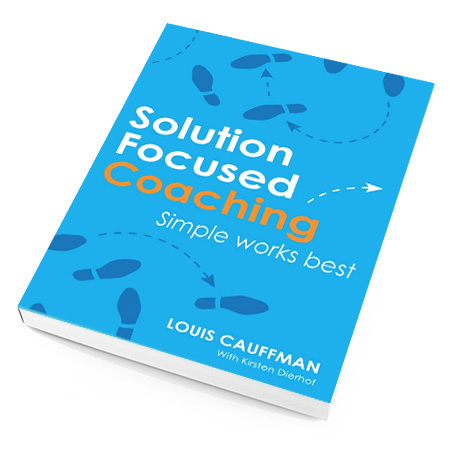Episode 10 – The Man in the Middle: A Solution Focused Feuilleton
Steve: “OK, but that doesn’t have to be a problem. Couldn’t you hold small, informal meetings? Show up at the coffee machine more frequently, stuff like that? During those occasions you could talk about the dismantling project. Without telling anyone, you could design a master plan for the dismantling project and cut it down into small pieces. You have done it before, so you know how to do it, and it sure was successful! You could do this in a few days, couldn’t you? When you are ready with it, you casually mention your plan during a coffee break or lunch, and you just wait and see how your teammates react to it. What do you think, Peter, is this feasible?”
Peter: “I would really like that idea if it weren’t for John, who, I’m pretty sure, will interfere and block me. Then I’m back to square one and I don’t want that to happen.”
Steve: “You are absolutely right. However, I don’t think it has to be like that. You’ve told me that everyone, including you, is impressed by the way John is able to keep everything under control. So, then it only seems logical to me that he will want to control this project as well, whether you like it or not. So, you have to find a way to let John do his job without you being bothered by him.”

When it comes to discussing work with his team on the project, Peter is on the buyer position. On the topic of his working relationship with John, Steve acknowledges that Peter is still on the passer-by position: Peter believes that John is the one who has to change, and he doesn’t see what he can do to facilitate that. Therefore, Steve uses an intervention that is suitable for passers-by. He negotiates about an alternative goal. What does Peter have to do differently to get John off his back?
Furthermore (and this is an example of a “high-tech” solution-focused intervention) Steve sees John as a passer-by: John will not change by himself and will keep his controlling method. Now Steve begins teaching Peter how to deal with passers-by effectively: by giving Peter a seemingly logical explanation about why John couldn’t do more than he is doing now (namely controlling and having too little confidence in others), he helps Peter to accept John’s way of working. At the same time, he offers Peter an alternative idea that will help him get around John’s resistance to let go of his controlling method. This is of course not easy, but let’s see how it can be done!
Peter: “Well, I’m curious. How are you going to pull that off?”
Steve: “It isn’t a matter of ‘pulling something off’, and by the way, I’m not going to do anything — you are. Imagine yourself in John’s position. After all, he is the boss and so he has the final responsibility for the project department. It is his task to make sure that the entire project department runs perfectly, or, at least, as well as possible. John knows — as you would if you were in John’s shoes — that he is good at this, but he is also very worried because he can’t do everything himself. He simply has to let others do a big part of the work. Imagine yourself in John’s position, Peter. What would you need to see happening so that you would be sure that everything goes OK?”
Peter: “I never looked at it that way. I always thought that he acted like a control freak to improve his own career. But I guess John is actually in a very tricky situation. After all, he is new to this company, and he is a lot younger than I am and his lack of experience maybe makes him a little insecure. Insecure people tend to overreact. I know that because I have been there.” (Smiles.)
Steve: “Correct. Wisdom comes with the years. How could you reassure him in such a way that he would no longer bother you?”
Peter: “I would probably have to give him more information so that he would know the project is going smoothly.”
Steve: “I don’t think that that will be enough. Wouldn’t you become suspicious if your employees only brought you good news? Wouldn’t you start to think that they were hiding something from you?”
Peter: “Probably … I recognize that. Maybe it will help if I also consult with him about some minor problems. It’s maybe a little cynical but that will give him the opportunity to indulge his need for control. Since I know in advance what will happen, I won’t be irritated. Yes, that’s it. I will regularly walk into his office and update him on how things are going. On these occasions I will tell him some problems that he can tackle with his expertise. Now that I say it out loud, I realize that some of my employees use that trick on me too — and it does make me feel better. Maybe it will work on him too. It sure is worth trying. What do you think, Steve?”
Steve: “Excellent, Peter, just do it. You do realize that you will have to talk to John instead of avoiding him?”
Peter: “Yes. But if we want to keep working for Solteam we have to work together. So, we’d better cooperate. Hey, I am starting to talk like you. (Giggles.) Anyhow, if that burden lessens, I will find the energy to busy myself with my team.”
Steve: “Go for it, Peter. Good luck. When do you think it will be useful for us to meet again?”
With this intervention Peter reaches the position of co-expert he has a workable request for help and has access to his resources. The fact that he comes up with this last proposal by himself is an indication to Steve that Peter is now able to help himself. From here on,
Peter only needs supervision in order to continue on the solution- focused path.
(to be continued)
Read episode 11
Back to episode overview
‘The Man in the middle’ is an excerpt from the book ‘The Solution Tango’ (and ‘Solution Focused Coaching’ e-book) by Louis Cauffman. This book presents a new approach to conquering the numerous challenges, problems, and failures that managers encounter at work, many of which are people-related. An important lesson identified in the book is that a manager must act as both the leader who provides direction for a team or company and as the coach who enables others to make the most of their skills, enabling the individual and the organization to succeed. A seven-step framework to enhance problem-solving capabilities, examples and tips, and a survival kit for sinking managers will help managers improve their people skills and learn how to approach everyday issues from a positive perspective.
 LOUISCAUFFMAN.COM
LOUISCAUFFMAN.COM
